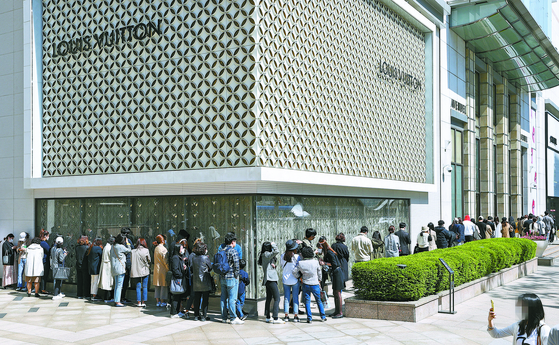In 2020, when consumption was stagnant due to the novel coronavirus infection (Corona 19), the millennial generation rather emerged as a big hand in the golf equipment and luxury goods market. One out of three imported cars was purchased by 30.

On the morning of May 13, last year, customers lined up in front of the main store at Lotte Department Store in Seoul. yunhap news
2030 increase in golf course finding
According to KB Kookmin Card on the 17th, golf course sales increased by about 10% compared to 2019 for three months from March last year when the World Health Organization (WHO) declared the corona pandemic and social distancing was implemented. Among them, the increase in golf course card usage by those in their twenties (+7.2%) and thirties (+6.1%) was remarkable compared to the existing main customers in their 40s (-1.1%) and 50s (+0.1%).
Golf-related products were also sold on fire. According to online shopping mall GMarket data, the number of golf products purchased by customers in 2030 in the first half of last year compared to the first half of 2019 showed an even growth in golf fittings (+47%), golf accessories (+29%), and women’s golf apparel (+22%). Showed. During the same period, the growth rate of the purchase of golf equipment among the middle-aged and elderly was only 13%.
In the imported car and luxury goods market, the influence of 2030 was remarkable. From January to November last year, 245,440 imported cars were sold in Korea. Compared to the same period in 2019 (214,708 units), this is an increase of 13.4%. Dividing the 154,501 units of individual purchases by age, 30s (49,650 units) bought the most imported cars. It was followed by those in their 40s (49,617) and their 50s (3,672). The proportion of people in their twenties (8766, 5.7%) was not small.

Increased imported car sales. Graphic = Reporter Cha Junhong [email protected]
In the distribution industry, even the end of 2030 was the’saving pitcher’ of last year’s department store sales. The proportion of luxury goods sales of 2030 customers at Lotte Department Store rose every year to 38.2% in 2018, 41.4% in 2019, and 44.9% last year, reaching nearly half of the total. Industry analysis shows that the 2030’flex (a form of consumption that emphasizes self-satisfaction and buys expensive items)’ was largely influenced by the decrease in sales of the entire department store and sales of luxury stores alone.

Share of luxury goods sales from customers in Lotte Department Store 2030. Graphic = Reporter Cha Junhong [email protected]
Either’Flex’ or earn 1.62 million won per month
However, the emergence of 2030, which controls the luxury market, does not mean the abundance of the entire youth generation. Rather, the gap between the rich and the poor is deepening even among the youth.
According to a report on’Changes in Wage Inequality by Region’ released by the Korea Employment Information Service in January, the Gini coefficient in the first half of last year was 0.306, up 0.012 points from the same period last year (0.294). The Gini coefficient is a representative income distribution index representing wage inequality, expressed as a number from 0 to 1, and the closer to 1, the greater the inequality.
Among them, the inequality of wages among young people under the age of 29 was remarkable. The Gini coefficient for those under the age of 29 rose 0.017 points from 0.197 in the first half of 2019 to 0.214 in the first half of last year. This was greater than the rise of those aged 30 to 54 (0.011) and over 55 (0.014) during the same period. The average monthly wage of non-regular young workers (1.62 million won) was only 61% of that of regular workers (265 million won).
Sungkyunkwan University Sociology Professor Koo Jeong-woo said, “In order to resolve inequality within the youth generation, a macroscopic approach is needed, such as how to resolve the education gap and wage gap, and what re-education to resolve the manpower mismatch among the graduates of the humanities department. I don’t lose.”
Reporter Jiyu Hong [email protected]
